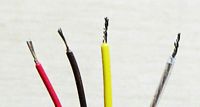Twisting & tinning wires
These steps are only important when working with stranded wires. If you are working with solid copper wire, then ignore this section.
Twisting and tinning stranded wires are two very important steps in the building of good quality cables. Failure to follow these steps can cause wires to not go into solder holes or cups properly, or some of the wire strands will come out and possibly create thin shorted connections where you can't see them and cause bad cables.
First, after the wires have been stripped back, typically exposing about 1/4" (5 mm) of base stranded wire, grasp the end of the exposed wire between the thumb and first finger and twist several times in a consistent direction so that all the wire strands now form a spiral.
Next, quickly solder each twisted wire so that the strands form a solid group. You may want to trim off the end millimeter of the wires as they tend to get sharp or pointy and the twisting usually doesn't get to the last bit of the wire. Since each wire now has solder on it they are much easier to work with and will solder to posts, pins or connector cups much cleaner and faster. You will also find that the wire strands will not come out of the group as easily.
 |
The left 2 wires are not twisted or tinned, the right two are. |
Email the author: Peter Schepers | Last updated: Mar 14, 2009